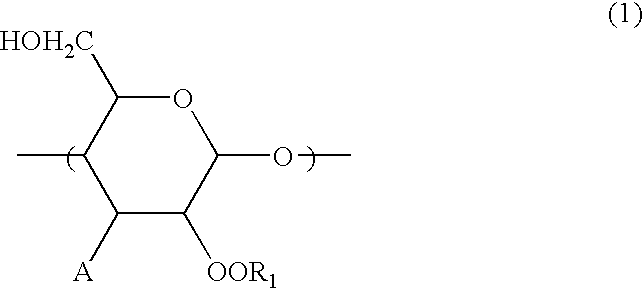Curable starch composition, modified starch, preparation method and articles
a technology of curable starch and composition, which is applied in the directions of starch dervative coating, transportation and packaging, adhesive types, etc., can solve the problems of accelerating the global tendency of becoming, needing useless energy, and adverse influences on global environments
- Summary
- Abstract
- Description
- Claims
- Application Information
AI Technical Summary
Benefits of technology
Problems solved by technology
Method used
Image
Examples
preparation example 1
[0196] (Preparation of Modified Starch 1)
[0197] Into 200 g of dimethylsulfoxide (DMSO) was suspended 25 g of high amylose corn starch, followed by heating up to 90.degree. C. with agitation, keeping at that temperature for 20 minutes to be gelatinized, adding 20 g of sodium bicarbonate as a catalyst to the gelatinized solution, adding 17 g of vinyl laurate (C.sub.12) while keeping at 90.degree. C., reacting at that temperature for one hour, adding 37 g of vinyl acetate (C.sub.2), reacting at 80.degree. C. for one hour, casting the reacting reacted solution, and successively subjecting to high speed agitation-grinding and filtration-dehydration drying to obtain a starch ester as modified starch 1. The modified starch 1 had an aliphatic group substitution degree of 2.45.
preparation example 2
[0198] (Preparation of Modified Starch 2)
[0199] Preparation Example 1 was duplicated except that 16 g of stearic acid chloride (C.sub.18) was used in place of vinyl laurate to obtain a starch ester as modified starch 2, which had an aliphatic group substitution degree of 2.45.
preparation examples 3-8
[0200] (Preparation of Modified Starches 3-8)
[0201] The high amylose corn starch and a modifying compound as shown in the following Table 1 were reacted so that the substitution degree may be as shown in the following Table 1 to obtain modified starches 3-8 containing a reactive group respectively.
[0202] Details of the above modified starches 1-8 are shown in the following Table 1.
1 TABLE 1 modi- fying com-modified starch pound substituent 1 2 3 4 5 6 7 8 Aliphatic (a) {circle over (1)} 2.4 2.4 2.4 2.4 2.4 2.4 0 group substitution (b) {circle over (2)} 2.4 degree Reactive (c) {circle over (3)} 0.1 group substitution (d) {circle over (4)}0.1 degree (e) {circle over (5)} 0.1 (f) {circle over (6)} 0.1 (g) {circle over (7)} 0.1 In Table 1, the modifying compound is as follows respectively. (a) vinyl laurate and vinyl acetate. (b) stearic acid chloride and vinyl acetate. (c) vinyl laurate and acrylic acid. (d) vinyl laurate and maleic anhydride. (e) vinyl laurate and methacrylisocyanate....
PUM
| Property | Measurement | Unit |
|---|---|---|
| mean particle size | aaaaa | aaaaa |
| mean particle size | aaaaa | aaaaa |
| thickness | aaaaa | aaaaa |
Abstract
Description
Claims
Application Information
 Login to View More
Login to View More - R&D
- Intellectual Property
- Life Sciences
- Materials
- Tech Scout
- Unparalleled Data Quality
- Higher Quality Content
- 60% Fewer Hallucinations
Browse by: Latest US Patents, China's latest patents, Technical Efficacy Thesaurus, Application Domain, Technology Topic, Popular Technical Reports.
© 2025 PatSnap. All rights reserved.Legal|Privacy policy|Modern Slavery Act Transparency Statement|Sitemap|About US| Contact US: help@patsnap.com



